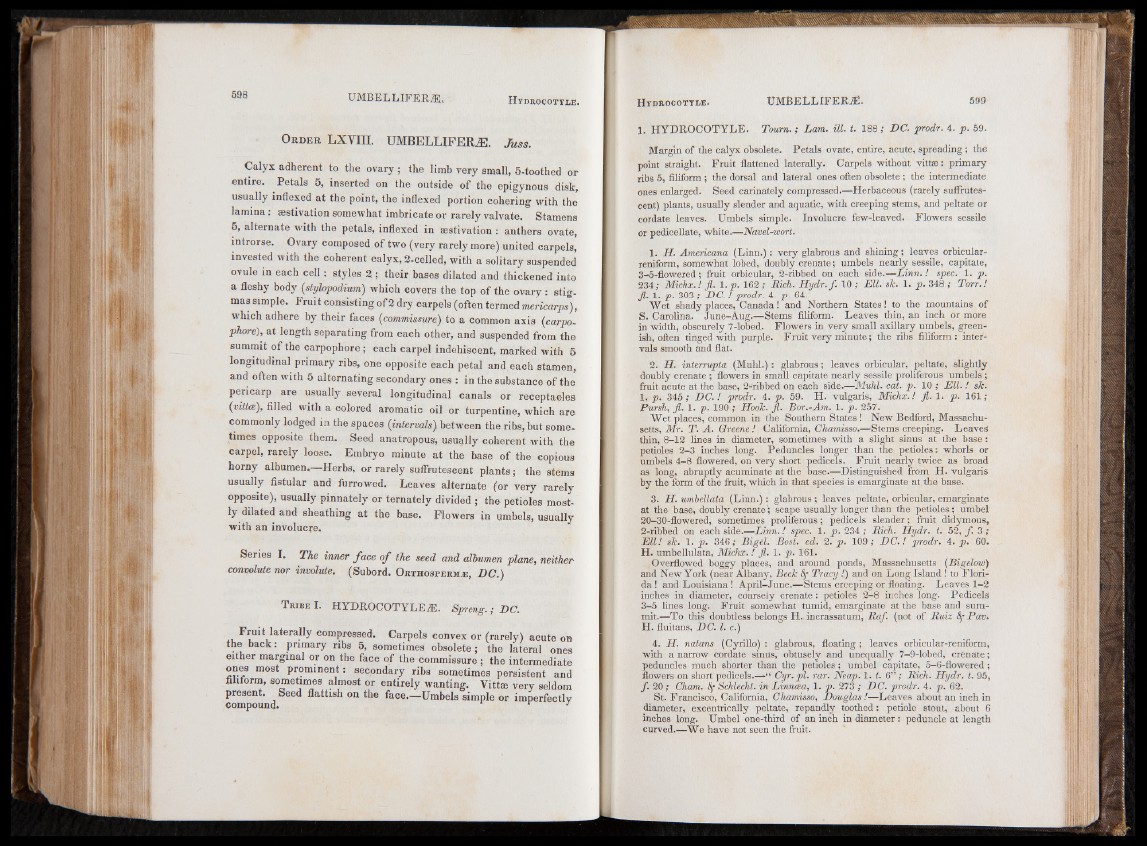
Or d e r LXVIII. UMBELLIFERjE. Ju ss.
Calyx adherent to the ovary ; the limb very small, 5-toothed or
entire. Petals 5, inserted on the outside of the epigynous disk,
usually indexed at the point, the indexed portion cohering with the
lamina: aestivation somewhat imbricate or rarely valvate. Stamens
5, alternate with the petals, indexed in aestivation: anthers ovate,
introrse. Ovary composed of two (very rarely more) united carpels,
invested with the coherent ealyx, 2-celled, with a solitary suspended
ovule in each c e ll; styles 2 ; their bases dilated and thickened into
a deshy body (sty lo p o d bm ) which covers the top of the ovary : stigmas
simple. Fruit consisting of 2 dry carpels (often termed mericarps),
which adhere by their faces (commissure,) to a common axis (carpo-
phore), a t length separating from each other, and suspended from the
summit o f the carpophore ; eaeh carpel indehiscent, marked with 5
longitudinal primary ribs, one opposite each petal and each stamen,
and often with 5 alternating secondary ones : in the substance of the
pericarp are usually several longitudinal canals or receptacles
(mttcB), filled with a colored aromatic oil or turpentine, which are
commonly lodged in the spaces (intervals) between the ribs, but sometimes
opposite them. Seed anatropous, usually coherent with the
carpel, rarely loose. Embryo minute a t the base o f the copious
horny albumen.—Herbs, or rarely sufiruteseent p lan ts; the stems
usually fistular and furrowed. Leaves alternate (or very rarely
opposite), usually pinnately or ternately divided ; the petioles mostly
dilated and sheathing a t the base. Flowers in umbels, usually
with an involucre.
Series I. The inner face of the seed and albumen plane, neither
convolute nor involute. (Subord. O r t h o s p e rm ^e , DC.')
T r ib e I. HYDROCOTYLEiE. Spreng. ; DC.
Fruit laterally compressed. Carpels convex or (rarely) acute on
the back: primary ribs 5, sometimes obsolete; the lateral ones
either marginal or on the face of the commissure; the intermediate
ones most prominent: secondary ribs sometimes persistent and
filiform, sometimes almost or entirely wanting. Vittae very seldom
present. Seed flatfish on the face.—Umbels simple or imperfectly
compound. J
1. HYDROCOTYLE. Tourn.; Lam. ill. t. 188 ; DC. prodr. 4. p . 59.
Margin of the calyx obsolete. Petals ovate, entire, acute, spreading ; the
point straight. Fruit flattened laterally. Carpels without vittae: primary
ribs 5, filiform; the dorsal and lateral ones often obsolete ; the intermediate
ones enlarged. Seed carinately compressed.—Herbaceous (rarely suffrutes-
cent) plants, usually slender and aquatic, with creeping stems, and peltate or
cordate leaves. Umbels simple. Involucre few-leaved. Flowers sessile
or pedicellate, white.—Navel-wort.
1. H. Americana (Linn.): very glabrous and shining; leaves orbicular-
reniform, somewhat lobed, doubly crenate; umbels nearly sessile, capitate,
3-5-flowered; fruit orbicular, 2-ribbed on each side.—L in n .! spec. 1. p.
234; Michx.! Jl. 1. p. 162 ; Rich. Hyd r.f. 10 ; Dll. sic. 1. p. 348 ; Torr.!
Jl. 1. p. 303 ; DC. ! prodr. 4. p. 64.
Wet shady places, Canada! and Northern States! to the mountains of
S. Carolina. June-Aug.—Stems filiform. Leaves thin, an inch or more
in width, obscurely 7-lobed. Flowers in very small axillary umbels, greenish,
often tinged with purple. Fruit very minute; the ribs filiform : intervals
smooth and flat.
2. H. interrupts (Muhl.) : glabrous; leaves orbicular, peltate, slightly
doubly crenate ; flowers in small capitate nearly sessile proliferous umbels ;
fruit acute at the base, 2-ribbed on each side.—Muhl. cat. p. 10 ; Dll. ! sk.
1. p. 345; DC.! prodr. 4. p. 59. H. vulgaris, Michx.! Jl. 1, p . 161;
Pursh, Jl. 1. p. 190 ; Hoolc. Jl. Bor.-Am. 1. p. 257.
Wet places, common in the Southern States ! New Bedford, Massachusetts,
Mr. T. A. Greene ! California, Chamisso.—-Stems creeping. Leaves
thin, 8-12 lines in diameter, sometimes with a slight sinus at the base :
petioles 2-3 inches long. Peduncles longer than the petioles: whorls or
umbels 4-8 flowered, on very short pedicels. Fruit nearly twice as broad
as long, abruptly acuminate at the base.—Distinguished from H. vulgaris
by the form of the fruit, which in that species is emarginate at the base.
3. H. umbellata (Linn.) : glabrous ; leaves peltate, orbicular, emarginate
at the base, doubly crenate; scape usually longer than the petioles ; umbel
20-30-flowered, sometimes proliferous; pedicels slender; fruit didymous,
2- ribbed on each side.—Linn.! spec. 1. p. 234 ; Rich. Hydr. t. 52, ƒ. 3 ;
Dll! sic. 1. p. 346; Bigel. Bost. ed. 2. p. 109; DC.! prodr. 4. p. 60.
H. umbellulata, Michx. ! Jl. 1. p. 161.
Overflowed boggy places, and around ponds, Massachusetts (Bigelow)
and New York (near Albany, Beck Tracy !.) and on Long Island ! to Florida
! and Louisiana ! April-June.—Stems creeping or floating. Leaves 1-2
inches in diameter, coarsely crenate : petioles 2-8 inches long. Pedicels
3 - 5 lines long. Fruit somewhat tumid, emarginate at the base and summit.—
To this doubtless belongs H. incrassatum, Raf. (not of Ruiz Sp Pav.
H. fluitans, DC. 1. c.)
4. H. natans (Cyrillo) : glabrous, floating ; leaves orbicular-reniform,
with a narrow cordate sinus, obtusely and unequally 7-9-lobed, crenate;
peduncles much shorter than the petioles; umbel capitate, 5-6-flowered ;
flowers on short pedicels.—“ Cyr.pl. far. Neap. 1. t. 6” ; Rich. Hydr. t. 95,
ƒ. 20 ; Cham. Schlecht. in Linneea, 1. p. 273 ; DC. prodr. 4. p. 62.
St. Francisco, California, Chamisso, Douglas !—Leaves about an inch in
diameter, excentrically peltate, repandly toothed: petiole stout, about 6
inches long. Umbel one-third of an inch in diameter : peduncle at length
curved.—We have not seen the fruit.